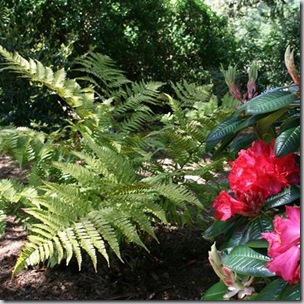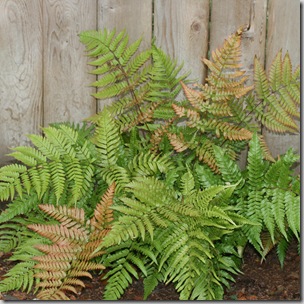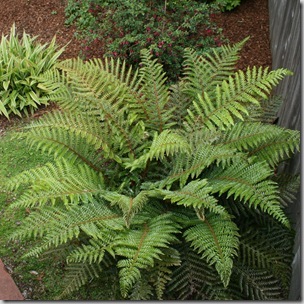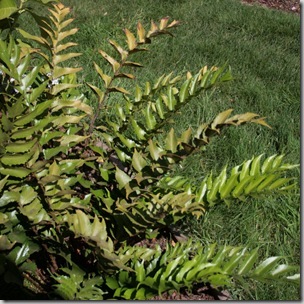As we settle more deeply into winter, I’ve been really noticing the beauty of all the ferns in the landscapes I care for. They’re low-care, often have great winter interest, and seem to go with just about every type of plant or style of planting.
The neat thing about ferns is they look great both on their own as focal points, and in broad drifts or masses. They’re generally resistant to deer, can take shade, and, um, they’re green! So you’d have to try really hard to make them look clashy with anything.
Here are a few of my favorite ferns to use in the landscape:
 |
Giant Chain Fern, Woodwardia fimbriata, is a Pacific Northwest native that gets 4-5′ tall. It has a soft-looking texture and an airy habit that’s lovely next to evergreen shrubs.While these look great massed, the mature size of 5 feet makes it an excellent focal point in a small garden bed, or a good accent to highlight larger plants.
It’s not frost-hardy, so keep it protected under trees. It can take boggy conditions. |
 |
Autumn Fern, Dryopteris erythrosora, is named a bit backwards. You’d think that it puts on that lovely show of orange foliage in, well, autumn. Instead, the Autumn Fern’s showiest time is in spring, when all the new growth is brilliantly colored.This photo is of its summer look; mostly green with a bit of color to remind you why you planted it. Drought tolerant once established, Autumn Fern has the best color when given just a few hours of sun each day. 3′ when mature. |
 |
Tasmanian Tree Fern, Dicksonia antarctica, stands in for palms in my rainy climate, acting as a tropical sentinel in the garden. They grow about 12′ tall in most gardens and about 7′ wide, so if you’re looking for a petite tree that can take shade, look no further.Their highest use in the garden is as a grove flanking a winding and mysterious pathway to a stone fountain or water feature – it feels so prehistoric and primal. You can imagine the dinosaurs romping juuust out of eyesight. |
 |
Tassel Fern, Polystichum polyblepharum, (say thatthree times), has the most deliciously glossy foliage, and drooping cinnamon tips on spring as it unfurls.This is one fern that really truly prefers the shade; I’ve tested it in gardens where it gets 2-3 hours of direct sun and it just fries.
Otherwise, it’s proven unfussy, even tolerating wind in one seaside garden seeing as we were kind enough to give it good soil and water there. 3′ mature size. |
 |
Holly Fern, Cyrtomium falcatum, is for the inner-goth crowd. Not into that fluffy frondy crap? Want a fern with some bite to it? Here you are.It’s bold, architectural, and looks great in steel planters or near sculptural elements in the garden. It doesn’t actually bite, it’s not mean like holly, it just tries to look tough is all.
It gets about 3′ around and has the deepest green color in shade, going a lighter green color with some sun. |
Want to find some good planting partners for ferns? Check out these posts for more inspiration:
Hawt Plants for a Variety of Climates
Forget Halloween: Dark Beauties to Enjoy All Year
Callunas, Daboecias and Ericas: Demystifying the Different Types of Heather
13 responses to “Ferns for Every Garden”
[…] This post was mentioned on Twitter by Simon Smith, Genevieve Schmidt, Greta Smith, Goven Bestafarda, Planters Haven and others. Planters Haven said: Ferns for the Pacific Northwest Garden | North Coast Gardening: Five favorite ferns to suit every Pacific Northw… http://bit.ly/hiFBcx […]
Nice to see the plants we cannot grow – Cascadia is so rich in the ferns and mosses dept! But you are reminding me to post on the small variety of native desert ferns in our foothills…
I specified some groupings of another Holly Fern on a Florida bank project last year, so I hope that goes in, as per plan! A definite favorite.
I love ferns. But where I live is not the best climate for them, especially since I’m an advocate of water-wise landscaping. Any good ferns for dry landscaping?
Autumn Fern should be drought tolerant in shady locations once established. And I’d also recommend looking into native ferns. Are there any ferns that are naturalized where you live? Here, our Sword Fern and Deer Fern need no water once established.
Great question and point, Liz!
I’ve recently been bitten by the Fern bug and have been enjoying the leather leaf ferns.
Check out the heart shaped fern named Hemionitis arifolia , it would find itself in great company with all of the ferns that you mention above.
Thanks for the tip on that heart-shaped fern Michelle, I found a photo of it and it is lovely!!!
Seems like it might echo the foliage shape of our native ginger, Asarum caudatum. It’s a beauty.
I’m looking for a boston fern/fulffy ruffles fern that had pendulum type crests on the tips of the fronds. Anyone know name/where I can get some?
Your help would be very much appreciated.
Hi Mitzi, I’d look on Daves Garden – not only do they have a lot of photos, but they also have suppliers listed for each of their varieties. I don’t, unfortunately, know many suppliers of that type of fern, but I bet that a quick Google search for Dave’s Garden and Boston fern would elicit some helpful results.
my favorite fern is easily Deer Fern: http://green.kingcounty.gov/gonative/Plant.aspx?Act=view&PlantID=19. Have you tried that one before? I just bought one a month ago – hoping it will live! I love moss and ferns….glad to see this post!!
Gina, I love deer ferns! They do well in my area, since they’re a rampant native here among the redwoods. I love the black midribs on their fertile fronds in summer. I do think they were stuck with a rather lousy botanical name, though. Blechnum. Blech. Perhaps some kind botanist will help them out with that in future.
[…] enough without the added challenge of shade. While the usual suspects in such conditions – ferns, iris, astilbe and hosta – are beautiful, if you’re looking for a more interesting or […]
I have common fern in my garden, we live in Canada 7 miles north of the Montana border, they seem happy…producing new fronds BUT the new fronds are not as airy and graceful as they should be (strictly my opinion). The new fronds are spikey and the leaves are hard and short curled upon the stem…I have just transplanted them from the North side of the garage to a shady fence protected bed…help…